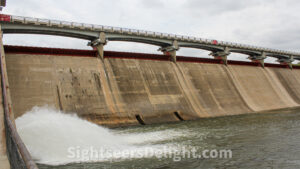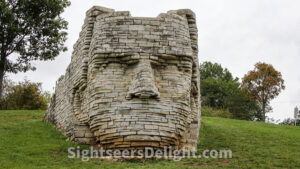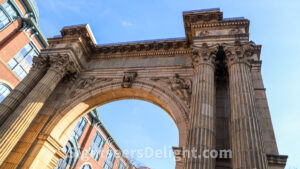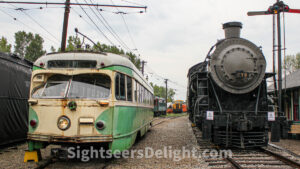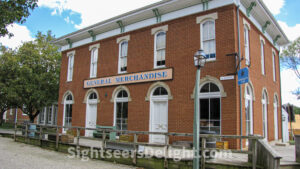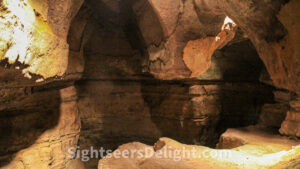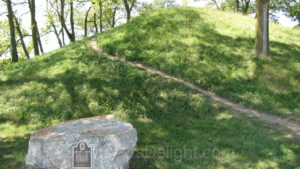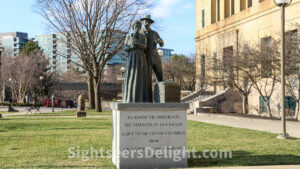Hoover Dam dams the Big Walnut Creek, forming the Hoover Memorial Reservoir, which holds 20.8 billion gallons of water. Construction began during 1953; the dam was dedicated in 1955 and officially opened in 1958. It was named for brothers Charles P. Hoover and Clarence B. Hoover in honor of their careers with the City of Columbus Waterworks.
Leatherlips is one of Ohio’s great historic legends. He was executed in on June 1, 1810, though the precise location is open to some debate. To honor the great Wyandot Native American Chief, the Dublin, Ohio, community in 1990 unveiled a 12-foot high sculpture of Leatherlips’ head. Designed by Boston artist Ralph Helmick and located in Scioto Park, the portrait was made using stacked native limestone. The top is open with stacked stones extending back along its sides, making for a popular picture stop.
43065
McFerson Commons is a 2.2-acre park in Columbus’ Arena District. McFerson Commons was previously named Arena Park. The park’s centerpiece is the Union Station arch. Daniel Burnham & Co. designed Union Station. The arch was salvaged before the demolition of the station in the 1970s.
43215
Founded in 1948 and incorporated in 1950, the Ohio Railway Museum is among the oldest railroad museums in the country. The museum operates over the former Columbus, Delaware, and Marion Railway right-of-way. One of its key locomotives on display is Norfolk & Western No. 578, an American Locomotive Co. 4-6-2 “Pacific” E2a steam locomotive. Built in March 1910, the steamer is said to be one of the last surviving E2a locomotives built for the Norfolk and Western Railway Co.
43085
Construction on the Ohio Statehouse started in 1839, and the structure was completed in 1861 and is considered to be a significant architectural accomplishment. The edifice, the seat of Ohio’s government, has been restored to its 1861 appearance. To learn more about the Buckeye State can venture to the Ohio Statehouse Museum Education Center on the ground floor of the statehouse. Visitors can participate in a tour or wander the museum at their own pace. A monument to President William McKinley, a native of Niles, Ohio, stands in front of the statehouse.
43215
The Ohio Historical Society operates the Ohio Village living history museum. The 15-acre museum, which opened on July 27, 1974, aims to give a firsthand view of life in Ohio during the Civil War. The village is home to 22 buildings, including a mix of reproductions and historic structures relocated to the site.
43211
The Olentangy Indian Caverns, located in Delaware, Ohio, north of Columbus, are a series of natural underground caves formed millions of years ago by an underground river that cut through the limestone rock. The cave’s passages and rooms occupying three different levels. According to the caverns’ webpage, Wyandots used the caverns over the years as a place of refuge from both their enemies (the Delaware Indians) and the weather.
43015
Shrum Mound was likely built between 800 BC and 100 AD. At approximately 100 feet in diameter and 20 feet tall, Shrum Mound is said to be “one of the last remaining conical burial mounds” in Columbus. The grass-covered mound features a path leading to the top. The mound is located in Campbell Park, named for former Ohio Gov. James E. Campbell who later served as president of the Ohio Archaeological and Historical Society. The mound derives its name from the Shrum family, which in 1928 donated the land where the mound sits to the Ohio Historical Society.
43204
The Columbus Italian Club commissioned this sculpture, created by Gary Ross, in 1992. The statue is on display in Battelle Riverfront Park along the Scioto River.
Anyone who says the judiciary does not loom large over society has never been to downtown Columbus. Artist Andrew Scott designed the 30-foot-long stainless steel gavel that today sits outside the Thomas J. Moyer Ohio Judicial Center, which is home to the Ohio Supreme Court. The gavel was installed in 2008.
43215

